AAO-NANOS Neuro-Ophthalmology Clinical Collection: Derived from the AAO-NANOS Clinical Neuro-Ophthalmology collection produced on CD. The images are of selected cases from the NANOS teaching slide exchange, and the CD was produced under the direction of Larry Frohman, MD and Andrew Lee, MD.
The American Academy of Ophthalmology (AAO); The North American Neuro-Ophthalmology Association (NANOS).
NOVEL: https://novel.utah.edu/
TO
| Title | Creator | Description | ||
|---|---|---|---|---|
| 176 |
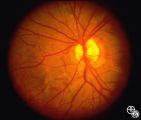 |
Systemic Disorders With Optic Nerve and Retinal Findings | Robert F. Saul, MD | This patent has known pseudoxanthoma elasticum (an uncommon elastic tissue disorder characterized by plaque-like skin folds [plucked chicken skin], and degeneration of collagen fibers involving multiple systems, including the GI tract and heart), angioid streaks, and optic disc drusen. |
| 177 |
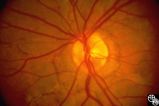 |
Systemic Disorders With Optic Nerve and Retinal Findings | Robert F. Saul, MD | This patent has known pseudoxanthoma elasticum (an uncommon elastic tissue disorder characterized by plaque-like skin folds [plucked chicken skin], and degeneration of collagen fibers involving multiple systems, including the GI tract and heart), angioid streaks, and optic disc drusen. |
| 178 |
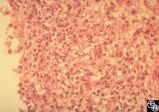 |
Optic Neuropathies | Larry P. Frohman, MD | The patient is a 66-year-old man with a history of ethanol abuse. He presented with 3 months of right-sided headache and a few days of progressive visual loss OD to hand motions only. When seen by the orbital service, he had nearly complete ophthalmoplegia and ptosis. Sinus biopsy showed fungus, whi... |
| 179 |
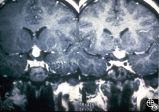 |
Ocular Manifestations of Congenital/Inherited Diseases | Steven Galetta, MD | This 21-year-old woman had a 2-year history of blurred vision. A computerized visual field demonstrated a temporal defect OS. MRI confirmed a chiasmal mass lesion. The pathology was consistent with hemangioblastoma. Further workup revealed retinal angiomas and multiple other hemangioblastomas of the... |
| 180 |
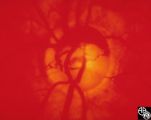 |
Isolated Congenital Optic Disc Anomalies | Thomas R. Wolf, MD | Optociliary shunt vessels are venous collaterals that form in response to chronic venous obstruction, shunting the venous blood from the retinal circulation into the choroidal circulation. Although they may be congenital, they may occur in patients with chronic disc edema, following central retinal ... |
| 181 |
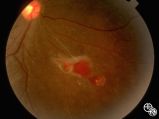 |
Ocular Manifestations of Systemic Disorders | Larry P. Frohman, MD | The same young woman from Case 77 (Image 92_57) presented 8 years after the orbital biopsy with this retinal lesion, presumably from her underlying disorder. The eye has 20/20 vision and no other disturbances. This is a fundus photo. |
| 182 |
 |
Neuro-Ophthalmic Vascular Disease | Anthony C. Arnold, MD | This 76-year-old woman has a 7-month history of redness and pressure sensation in both eyes that is worse in the morning. She has noted intermittent horizontal diplopia during this time. Angiography demonstrated a right dural cavernous sinus fistula, which was successfully occluded with direct injec... |
| 183 |
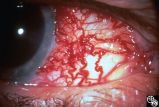 |
Neuro-Ophthalmic Vascular Disease | Anthony C. Arnold, MD | This 76-year-old woman has a 7-month history of redness and pressure sensation in both eyes that is worse in the morning. She has noted intermittent horizontal diplopia during this time. Angiography demonstrated a right dural cavernous sinus fistula, which was successfully occluded with direct injec... |
| 184 |
 |
Neuro-Ophthalmic Vascular Disease | Anthony C. Arnold, MD | This 76-year-old woman has a 7-month history of redness and pressure sensation in both eyes that is worse in the morning. She has noted intermittent horizontal diplopia during this time. Angiography demonstrated a right dural cavernous sinus fistula, which was successfully occluded with direct injec... |
| 185 |
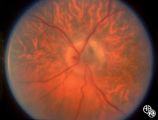 |
Congenitally Tilted Optic Disc | Anthony C. Arnold, MD | Colobomas or defects of the optic nerve may exhibit spontaneous pulsations. Disease/Diagnosis: Coloboma. |
| 186 |
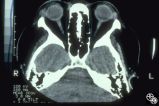 |
Neuro-Ophthalmic Imaging-CT Scan | Larry P. Frohman, MD | This 39-year-old woman's initial sign was painless, progressive, symmetric ptosis OU, without diurnal variation, that manifested when she was age 17 living in the Dominican Republic. At that time, she had no diplopia or systemic signs. She had no family history of ocular or muscle disease, and no ot... |
| 187 |
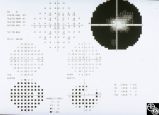 |
Isolated Optic Neuritis/Neuropathy | Larry P. Frohman, MD | The patient is a 62-year-old female who presented in August 1996 with visual loss OD that she first noted as loss of her superior field in May 1996. She felt that it had been static since, and perhaps was even a little better in the week before she was seen. There was no pain, even with ocular rotat... |
| 188 |
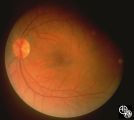 |
Neuro-Ophthalmic Vascular Disease | Larry P. Frohman, MD | This 32-year-old woman was referred with a history of 4 days of loss of vision OD. She had a history of manic depressive illness and IV drug abuse; she had been HIV tested 4 weeks before and was negative. She said she last injected cocaine 5 days before being seen, the night before she awoke with th... |
| 189 |
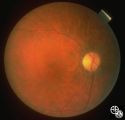 |
Neuro-Ophthalmic Vascular Disease | Larry P. Frohman, MD | This 32-year-old woman was referred with a history of 4 days of loss of vision OD. She had a history of manic depressive illness and IV drug abuse; she had been HIV tested 4 weeks before and was negative. She said she last injected cocaine 5 days before being seen, the night before she awoke with th... |
| 190 |
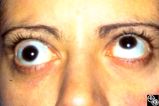 |
Neuro-Ophthalmic Vascular Disease | Larry P. Frohman, MD | This 32-year-old woman was referred with a history of 4 days of loss of vision OD. She had a history of manic depressive illness and IV drug abuse; she had been HIV tested 4 weeks before and was negative. She said she last injected cocaine 5 days before being seen, the night before she awoke with th... |
| 191 |
 |
Isolated Optic Neuritis/Neuropathy | Daniel M. Jacobson MD | This 35-year-old otherwise-healthy woman developed typical optic neuritis OD with excellent recovery. She had no clinical evidence of multiple sclerosis at that time. She presented in August of 1991, at which time perivenous sheathing was seen in the retinal periphery OU. A limited workup was negati... |
| 192 |
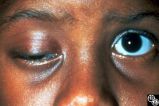 |
Motility Disturbances | Rosa A. Tang, MD | Cyclical oculomotor paresis may occur in patients as an intermittent phenomenon, with a paretic phase and diplopia and intervals that are nonparetic. The history and examination are classic for the disorder. Pair with Images 95_19 and 95_20. |
| 193 |
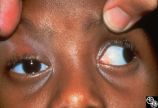 |
Motility Disturbances | Rosa A. Tang, MD | Cyclical oculomotor paresis may occur in patients as an intermittent phenomenon, with a paretic phase and diplopia and intervals that are nonparetic. The history and examination are classic for the disorder. Pair with Images 95_18 and 95_19. |
| 194 |
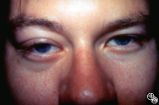 |
Ocular Manifestations of Systemic Disorders | Rosa A. Tang, MD | Systemic lymphoma may occur in the orbit and may involve the lacrimal gland. Patients usually present with a painless, progressive proptosis or a mass. CT scan usually demonstrates an irregularly shaped lesion conforming to the globe or lacrimal fossa, and bone erosion is not usually found. Pair wit... |
| 195 |
 |
Ocular Manifestations of Systemic Disorders | Rosa A. Tang, MD | Systemic lymphoma may occur in the orbit and may involve the lacrimal gland. Patients usually present with a painless, progressive proptosis or a mass. CT scan usually demonstrates an irregularly shaped lesion conforming to the globe or lacrimal fossa, and bone erosion is not usually found. Pair wit... |
| 196 |
 |
Systemic Disorders With Optic Nerve and Retinal Findings | Rosa A. Tang, MD | Neoplasms may result in an optic neuropathy by direct metastatic involvement. In this patient, a lung adenocarcinoma was metastatic to the optic nerve.This is a fundus photo. |
| 197 |
 |
Motility Disturbances | Larry P. Frohman, MD | This young woman had bilateral sixth nerve paresis from a motor vehicle accident. The images show the results of a successful Jensen procedure. |
| 198 |
 |
Motility Disturbances | Larry P. Frohman, MD | This young woman had bilateral sixth nerve paresis from a motor vehicle accident. The images show the results of a successful Jensen procedure. |
| 199 |
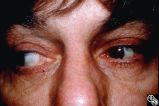 |
Motility Disturbances | Larry P. Frohman, MD | This patient sustained a traumatic avulsion of the left medial rectus. Image 94_75 shows the successful postoperative result. |
| 200 |
 |
Motility Disturbances | Rosa A. Tang, MD | Cyclical oculomotor paresis may occur in patients as an intermittent phenomenon, with a paretic phase and diplopia and intervals that are nonparetic. The history and examination are classic for the disorder. Pair with Images 95_18 and 95_20. |
